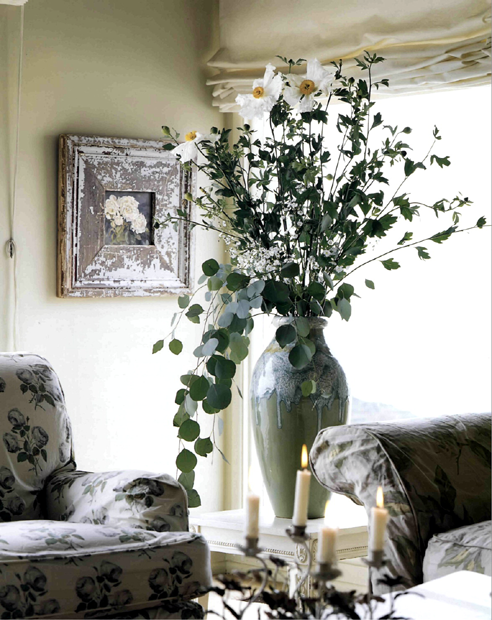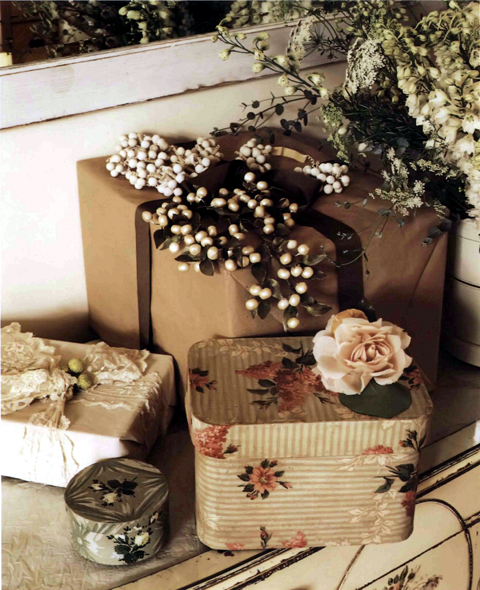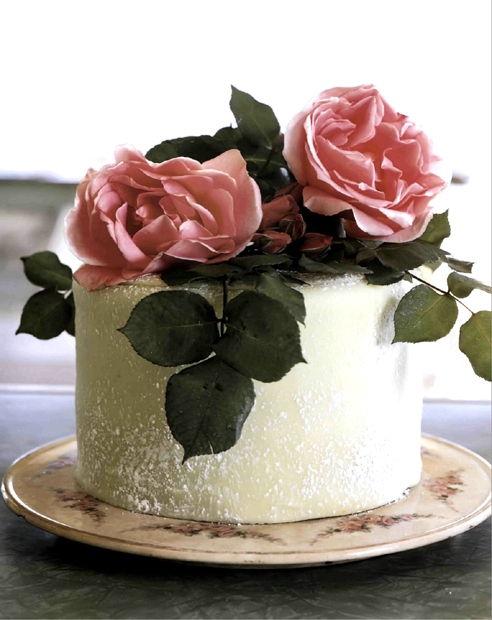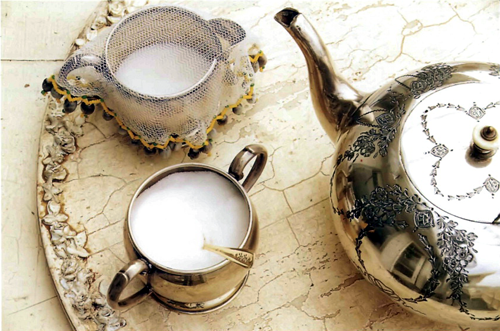

Because of their undefined, almost blurry shape, muted coloring, and soft texture, peonies, available in many varieties, are good flowers for casual arrangements.
Real flowers and their abstract representations are one of the most important characteristics of the Shabby Chic style and an essential ingredient for creating the simple, unaffected look I love. As reminders of the natural evolution of life and the beauty of all its stages—from glorious budding and blossoming to delicate withering and fading—flowers bring the outdoors into the home, adding life, color, and fragrance.

Unexpected colors, a bit of humor, or an offbeat pattern on a vase can prevent a floral arrangement from being too romantic. The lively, circuslike polka dots of this glass bowl offset the dreaminess of the roses and lend the arrangement a bit of whimsy and modernism.

Large, loose arrangements can lend real impact without being overpowering, as demonstrated by these giant white poppies paired with eucalyptus leaves. This arrangement dominates the corner of the room while also blending in with its surroundings, picking upon the green floral print of the chairs and sofa and complementing the white floral oil painting behind it.
Farmer’s markets, fields, gardens, meadows, nurseries, and (lower marts in major cities are prime locations for finding quality fresh flowers. Farmer’s markets are my choice, as they are so accessible and usually offer a mishmash of meadow and field flowers that look less cultivated than flowers from other outlets. Large bunches can be purchased for anywhere from two to ten dollars. City flower marts are usually restricted to those with wholesale accounts, so unless you have a connection, they can be frustrating to use. I try to avoid hothouse flowers because they tend to look too artificial. Small imperfections and slight irregularities give flowers a more individual, natural feel.
Varieties of flowers that serve as good basics for the kind of bountiful arrangements I love include bearded iris, garden roses of all varieties, lavender, lilacs, Casablanca lilies, camellias, tulips, peonies, delphinium, hollyhocks, and dahlias. Mowers good for floating in bowls of water include lilies, orchids, roses, and gardenias.
Rounding out bouquets with fillers gives them more depth and fullness. Some of my favorite tillers include eucalyptus leaves (silver dollar or knife blade work better than spiral varieties), lemon leaves. Queen Anne’s lace, and flowering fruit branches, such as peach, apple, and cherry—but almost anything tall with interesting branches or leaves works well. Some tillers are available at farmer’s markets. Others can often be found in your own backyard or on a nature walk.
I prefer large and abundant arrangements in wide-lipped vases filled to bursting. Though bright flowers can be dramatic, I usually select more subdued hues, like dusty pinks, blues, lavenders, and creams and arrange them in monochromatic or subtle color variations. In keeping with the imperfect, comfortable look of the furniture and fabrics that appeal to me, I’m attracted to flower arrangements that are asymmetrical, irregular, wildly shaped, and loosely, almost haphazardly, assorted. An arrangement should never be so studied that it dominates the (lowers themselves. I much prefer random arrangements of flowers that can be enjoyed from all angles, like the flowers growing naturally in a garden. To keep an arrangement from becoming one-sided, I rotate the container as I work. I gravitate toward vases with unique details, preferably old ones with cracks and chips caused by the vagaries of time. Occasionally, an old vase will not be watertight, but that is a problem easily solved. Professional liners can be purchased inexpensively at most floral supply outlets. I often just place a glass jar filled with water inside the vase.

Orchids work well in sophisticated settings and bespeak an elegant beauty. Most orchids should be kept in light, airy soil or bark and misted as much as possible.

Just as the natural irregularities of flowers add to their beauty, imperfections in vases can hold appeal. The chipped flowers on this porcelain vase imbue it with a wilted feel that echoes the appearance of the roses inside. If such imperfections are too distracting, they can be covered up economically with a bit of nail polish.

For me, arranging flowers is not work but one of my most enjoyable pastimes. I love playing with roses in particular. If possible, work where you’ll have lots of room to spread out.


A giant bunch of garden roses is eye-catching wherever it is placed. Garden roses have bigger blooms and are more fragrant than the typical hothouse variety sold in most shops. Rather than being bred to look identical, garden-rose blooms are individual, with several buds or branches attached to each stem in a unique pattern. When placed in a group, the particular characteristics of the roses become all the more exaggerated.
Flowers need not be confined to short periods of display. The evolution of their life cycle, even in their later stages of subtle wilting and slight drooping, is a part of their appeal. Discarding an arrangement after a few days does not allow for an appreciation of its graceful aging, which can be as dramatic and beautiful as its peak, fresh from the garden display. I like to let petals that have fallen from an arrangement to the table below remain there as part of the look, (lathering the fallen petals in a porcelain or glass bowl (with or without water), using them in satchels of potpourri, or drying them are other ways of appreciating the loveliness of flowers longer. I also love the feeling of bringing the outside in with a potted rosebush. Not only is it a creative alternative to more predictable floral displays, it ultimately lasts longer and is less expensive. Costing anywhere from eighteen to twenty dollars each, rosebushes typically last for about two weeks before needing to be replanted outside.
While flower arrangements are common in living rooms and dining rooms, placing them in unconventional, less-expected locations can add new life to any space. An arrangement of flowers might pop up in a forgotten corner, a hallway, under the staircase, or at the edge of the bathtub. Fresh flowers—or those made of silk, velvet, or linen—can also be a wonderful surprise on a plain wrapped present, as an adornment for a frame, or decoration on a birthday cake. For gifts, I often just use a plain brown paper bag, adding flowers or vintage milliner’s trinkets in the shape of fruits and berries, and scraps of fabric, lace, string or raffia as trim. Old hat or vintage shoe boxes, which can be found at flea markets and secondhand shops, can also make very pretty containers for presents.

Fabric flowers can be used in place of real ones if they are made of high-quality material. Linen, velvet, and silk, for example, have the ability to mimic the soft folds and frays of real flowers.

Flowers, whether real or faux, make attractive accents for presents. Some butcher paper or paper bags, scraps of old fabric, ribbon or lace from around the house, and a bit of raffia or string are all you need to wrap a lovely gift.

Fresh flowers from the garden are an inexpensive, easy way to decorate cakes. The large roses atop this green marzipan cake make all the difference between ordinary and unique ornamentation.
• Have water immediately available when you are cutting flowers and put them in the water as soon as possible. For maximum freshness, flowers should never be out of water for very long.
• Cut stems with a sharp knife at a diagonal, scraping the sides an inch or so above the cut to maximize the amount of surface that can absorb water. If the stem is thick or woody, make a few crisscross cuts and scrape off an inch or two of bark up the stem so water can penetrate more easily.
• Remove all leaves below the vase line and any excess foliage. The idea is to steer the water to the flower, not to leaves that you can’t see. Remove blossoms and leaves as they die to conserve energy for the remaining flowers, unless, of course, you like the look of the wilting flowers.
• Always use clean water and add new water often, keeping the stems submerged, even if you change the water completely or move the flowers to a different container. Some stems are very delicate and can close up their cuts after only a few moments of air exposure.
• To revive flowers that have become droopy, completely submerge them in cold water for about an hour. This works for any flower that does not have a fuzzy texture (fuzzy-textured flowers tend to get water spots). Misting leaves in hot weather can also help refresh them.
• Bleach can act as a preservative for flowers by keeping the water clean and preventing bacteria growth and malodorous fumes. But don’t overdo it. A teaspoonful is sufficient. Professional floral additives, which inhibit bacteria, stimulate growth, and condition water can be purchased at florists or floral supply stores. Bleach is also good for cleaning containers thoroughly.

White tulips are a simple classic that works everywhere. Here Chantall Cloutier uses them to lighen up the richness of this dark corner of cobalt bowls and candles.


Most of the floral paintings I’m attracted to are from the turn of the century, when artists created less formal compositions. Although I don’t look for works by registered artists, sometimes I’ll happen upon a work that is by a well-known painter such as these pink roses by Marie Johansen (bottom). Sometimes, a painting doesn’t require a frame at all, such as this slightly more formal composition of fruits and flowers (top).
Oil and watercolor paintings of flowers are one of my favorite accessories for a room. Good examples tend to come from the mid- to late-Victorian era and depict flowers scattered randomly across the canvas rather than in the formal, stylized vase arrangements paired with birds or fruit that were predominant in the twenties. “Yard longs”—named for their size—are relatively rare, horizontal floral paintings or prints, mainly from the nineteenth century. The proportion of a yard long makes a good choice for hanging over couches or beds, in long hallways, or behind tables. Floral paintings have become extremely popular in the last few years, and so are much harder to find and more expensive than they used to be, although good ones can be found occasionally at flea markets.
I try to avoid paintings that require restoration, although small flaws can be covered up with minimal work. If a canvas has a small rip, as opposed to a missing piece, you can smudge a bit of oil paint that matches the color in the painting onto the front side of a piece of acid-free tape, then fasten the tape to the back of the canvas. Larger flaws can be repaired professionally, beginning at a cost of about two hundred dollars. One positive aspect of paintings with flaws is that you can bargain for better deals.

A frame can be as much a part of an artwork as the canvas. The size of this frame, made from an old architectural molding, almost overshadows this tiny painting of a rose in my living room. Chipped and peeling, the frame adds a feeling of glamour and delicate decay.

My favorite floral paintings are flowers simply laid across a table, unrestricted by a vase, framed with old architectural moldings.

These Victorian rose studies are a rare find. They are leftovers from an art school session in the late 1900s, when women used to gather in small groups and paint their own renditions of the same still lifes.
These teacups with “chintz” patterns and floral designs inside as well as outside are Jennifer Nicholson’s favorites. Here she uses them informally, with mismatched dishes and colors that complement one another. The worn pink table’s scratches and cracks are left to create an interesting contrast with the dainty floral teacups, fine linen napkins, and silver. Nicholson collects cups from small shops, flea markets, and antique sales all over the country. She much prefers these to perfectly matching pieces, which she finds to be too stiff and uniform. (See Resource Guide.)

The unique qualities of this silver teapot that my friend inherited from her grandmother are its delicate floral etchings and hinged lid. The creamer is covered with a shell and bead-trimmed net from Africa. The cracks in the wooden tray and the tiny reproduction roses added to its edge give this tea setting a wonderful, crumbling, shabby mood.

Beautiful form and useful function merge perfectly in this delicate, hand-made rose teacup belonging to Jennifer Nicholson. The muted color, wilted look of the petals, and the rosebud handles are examples of the types of details that make a piece exceptional.

This plain white wall in a hallway of Tony and Donna Scott’s home was turned into a visual feast of flowers, with every piece serving a practical purpose. Delicate Italian ironwork is shaped into sconces, a circular-trimmed candleholder frames a mirror, and a leaf-motif half-table provides the perfect spot for a flower-painted jug of fresh white roses.
Old architectural wooden moldings, their paint cracked and peeling, make eye-catching frames with lots of character, though a canvas with no frame at all is also appealing in its simplicity. Glass can be used to protect watercolors, but do not place it on oil paintings, as they need to breathe.
I often look for floral details on vintage wooden furniture, whether painted, etched, or in relief. Though some artists are masters at adding floral details to furniture, I much prefer pieces with original flower work—as evidenced by cracked, faded, and peeling paint.
Fabrics with floral patterns and accessories such as chandeliers, napkin rings, candlesticks, wastebaskets, lamps, and dishes adorned with flower shapes or painted floral details are additional ways to bring the appeal of flowers to a room. When combining different floral looks, a few well-chosen objects work better than an overabundance of knickknacks, and soft tones and subdued mixes work better than loud colors and sharp contrasts. In my living room and bedroom, for example, the use of complementary tones and subtleties of print and detail help prevent the floral motif from taking over, enabling the look to enhance rather than dominate the room.
Whether real or represented, flowers are a crucial element of interior decor, not only because of their natural beauty but because they enliven the static of the indoors with the more mutable, ephemeral, and sensory quality of the outdoors.

Flowers do not have to be fresh in order to bring a feeling of nature into a room, as in the intricate and delicate detailing of the flowers on these Italian candlesticks.

The decayed, delicate look of these dried roses is as beautiful as that of fresh flowers. To keep dried flowers from crumbling, spray them with hair spray and handle them gently. Like real flowers, they can be used in arrangements or to adorn hats or gifts, or can be hung simply in bunches from the wall.

Frilly, edged cotton tablecloths in pale colors left out to dry and benefit from fading by the sun make a lovely sight in their own right, surrounded by rose petals.